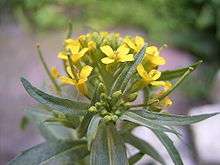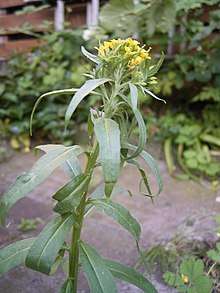Erysimum cheiranthoides
| Erysimum cheiranthoides | |
|---|---|
 | |
| Scientific classification | |
| Kingdom: | Plantae |
| Clade: | Angiosperms |
| Clade: | Eudicots |
| Clade: | Rosids |
| Order: | Brassicales |
| Family: | Brassicaceae |
| Genus: | Erysimum |
| Species: | E. cheiranthoides |
| Binomial name | |
| Erysimum cheiranthoides | |
| Synonyms | |
|
Cheirinia cheiranthoides | |
Erysimum cheiranthoides, the treacle-mustard or wormseed wallflower, is a species of Erysimum native to most of central and northern Europe and northern and central Asia.[1][2][3]
Description
It is a herbaceous, annual plant similar in appearance to many other mustards, growing an erect stem 15–100 cm (5.9–39.4 in),[4] (rarely 150 cm) tall.[5] The leaves are lanceolate to elliptic, 2–11 cm long and 0.5–1 cm broad, with an entire to coarsely toothed margin. It blooms in summer, between June and August.[4][6] The flowers are bright yellow, 5–12 mm diameter, produced in an erect inflorescence. Later, it produces a slender cylindrical capsule, 1–3 cm (rarely 5 cm) long, containing several small, pale brown,[4] or dark brown seeds.[2][3][7]
Taxonomy
It was formerly described by the Swedish botanist Carl Linnaeus in his seminal publication 'Species Plantarum' in 1753, on page 661.[8][9]
It is commonly known as treacle-mustard,[4] or wormseed wallflower.[6][5] The treacle mustard name came from the Greek word 'theriaki' meaning antidote to poisonous bites as the plant was thought to have healing properties. The name 'wormseed mustard' arose from the seeds of the plan being made into treacle, to treat intestinal worms in children.[4]
Distribution and habitat

Erysimum cheiranthoides is native to temperate areas of Europe and Asia.[10]
Range
It is found in Asia within China (in the provinces of Heilongjiang, Jilin, Nei Monggol and Xinjiang), Japan, Korea, Mongolia and Siberia. In Eastern Europe, it is found in Belarus, Estonia, Latvia, Lithuania, Moldova and Ukraine. In middle Europe, it is found within Austria, Belgium, the Czech Republic, Germany, Hungary, the Netherlands, Poland, Slovakia and Switzerland. In Northern Europe, in Denmark, Finland, Norway, Sweden and the United Kingdom. In Southeastern Europe, within Bosnia and Herzegovina, Bulgaria, Croatia, France, Romania, Serbia and Slovenia.[10]
It is also widely naturalised outside of its native range,[7][11] from New Zealand, other parts of Europe,[10] to North America,[12] (including parts of Canada and Argentina (in Tierra del Fuego).[10]
Habitat
It grows in disturbed areas, fields,[6] and dry stream beds.[5] It is normal found at altitudes of 0–3,000 m (0–9,843 ft) above sea level.[5]
Use
Herbalists in the 16th century, used the plant as a remedy for insect and animal bites.[4]
References
- ↑ Flora Europaea: Erysimum cheiranthoides
- 1 2 Blamey, M. & Grey-Wilson, C. (1989). Flora of Britain and Northern Europe. ISBN 0-340-40170-2
- 1 2 Flora of China: Erysimum cheiranthoides
- 1 2 3 4 5 6 Reader's Digest Field Guide to the Wild Flowers of Britain. Reader's Digest. 1981. p. 47. ISBN 9780276002175.
- 1 2 3 4 "FNA Vol. 7 Page 535, 539". efloras.org. Retrieved 21 November 2017.
- 1 2 3 "Erysimum cheiranthoides (Wormseed Wallflower)". minnesotawildflowers.info. Retrieved 21 November 2017.
- 1 2 Flora of NW Europe: Erysimum cheiranthoides
- ↑ "Erysimum cheiranthoides L. is an accepted name". theplantlist.org. Retrieved 21 November 2017.
- ↑ "Brassicaceae Erysimum cheiranthoides L." ipni.org. Retrieved 21 November 2017.
- 1 2 3 4 "Taxon: Erysimum cheiranthoides L." ars-grin.gov. Retrieved 21 November 2017.
- ↑ Med-Checklist: Erysimum cheiranthoides
- ↑ USDA Plants Profile: Erysimum cheiranthoides
![]()
![]()